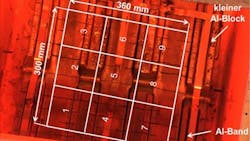Sensor-Based Optimization Saves Energy in Aluminum Melting
To determine the energy-savings potential for aluminum melting processes, minimize melting loss, and create the basis for a heat recovery system, researchers have developed a system for monitoring and controlling the melting process. Over four years, furnace builder ZPF GmbH led an R&D program funded by Germany’s Federal Ministry of Economics and Technology (BMWi). At the conclusion in 2016, the researchers reported a significant reduction in melting downtime, and the possibility for a 15% improvement in energy efficiency.
"The entire furnace system needs to be optimized in order to achieve sustainable improvements. This was the main finding from the previous project concluded in 2011, which was mainly concerned with new burner arrangements and alternative refractory material,” reported Sven-Olaf Sauke, of ZPF.
One focus of the research was to develop sensor-based measuring technology for the furnace chamber. This was intended to detect and quantitatively fix the local positioning of the residual material on the melting bridge.
Another objective was to find out how a dynamic furnace system can be aligned with the melting charge, on the basis of measured data, and whether the efficiency of the overall system can be increased as a result.
Each of the project partners was assigned “sub-projects” to research, according to their areas of expertise. Fundamental metrological analyses on energy savings and automation for aluminum melting processes were conducted at the Institute for Metal Forming Technology and Machinery at the Leibniz University of Hannover (IFUM). On this point, a corresponding sensor technology, that withstands the thermal conditions in the furnace had to be developed.
An optical camera technique turned out to be most suitable technique for this. "The camera, which was specially adapted for this project, allowed the monitoring and evaluation of a melting process currently in progress, for the first time. However, applicability is at present still limited by the efficiency of the technical elements,” Sauke explained.
Because velocity was critical for analyzing the measured data, but was insufficient in the image processing software used, the researchers developed a specific evaluation algorithm. In an initial step, this algorithm imports the data determined by the camera, and then generates a table in which the information of three images captured during the recording time are recorded. All coordinates that are outside the boundary areas of the aluminum ingot package are automatically deleted by the program and, in a third step, the remaining surface is divided into nine defined regions. Thus, the flow properties of the melt and the position of remaining aluminum residues can be determined systematically.
The cyclically collected, measured data was converted into a 3D model for further processing. Then, the model was converted into a coordinate system, which was required for activating the mobile furnace system.
The influence of the bath filling level on the exhaust gas outlet temperature and the melting down time of the ingots turned out to be low. Further inquiry was made of the pivoting of the burner and the resulting increase of the range affect of temperature distribution on the melting bridge. In this way, a significant increase in melting capacity could be proven in comparison to a static position.
"Consequently, the time needed for melting the aluminum residues is significantly reduced, which implies a considerable overall improvement in energy efficiency,” Sauke said of the simulation results.
All of the simulations were conducted at the Institute for Heat Technology and Thermodynamics (IWTT) of the Freiberg University of Mining and Technology. During the numeric simulations used to optimize the mode of operation of the dynamic system, both holding and melting operations were considered.
In addition, investigations were conducted to the furnace system in use at the IWTT, as well as on possibilities for reducing gas consumption. As a complementary measure, investigations seeking to reduce the melting loss and a major part of the hot tests under laboratory conditions were conducted at the Foundry Institute (GI) of the Freiberg University.
ZPF supported the collaborative project on fundamental questions, and took care of the software development, as well as the installation and testing of individual system components. In addition, it was responsible for the test phase, using a demonstrator, and for the industrial implementation and testing.
"For the field experiments, a demonstrator that was closely based on a series system (melting furnace, type SG 1.5T5, with a melting capacity of 1.5 mt/h and a holding bath capacity of 5 mt) was installed,” according to Sauke, “but it was equipped with a large number of special components, as required for the project type, such as those required for the entire measuring equipment.” Based on the coordinates transferred to the burner control by the measuring system, it was possible to swivel the system to the desired position via two servomotors. As a result, melting times could be reduced — without the quality being impaired — at a lower rate of gas consumption.
"Our initial expectations of 10 to 15% reduction in energy consumption have been met,” Sauke confirmed. “Measured data allow for the conclusion that this increase in efficiency is based on a reduction of the melting down time.”
The researchers now report that a foundation is in place for an industrial-scale research program. In order to draw further conclusions about an optimized mode of operation, they added, a few process improvements are necessary and further long-term tests are required.
"During another R&D project, to be launched in 2017 if possible, the main focus will be directed to variable burner positions and identifying possibilities for improvement of measuring sensor technology,” said Sauke. Among other things, an on-line monitoring unit is being considered, to increase the system security.
The medium- to longer-term objective is to incorporate the research findings into the development of furnace systems. "Once the technology is ready for series production, it will be for the benefit of all companies operating aluminum melting furnaces,” Sauke affirmed. “The use in other branches of industry in which process monitoring for hot areas is required, is imaginable.”
